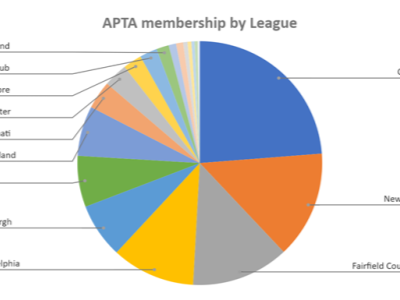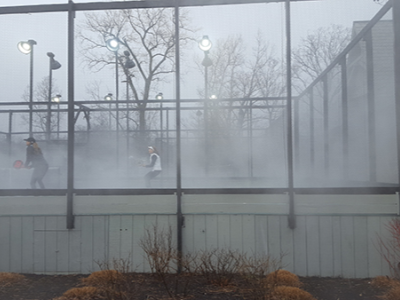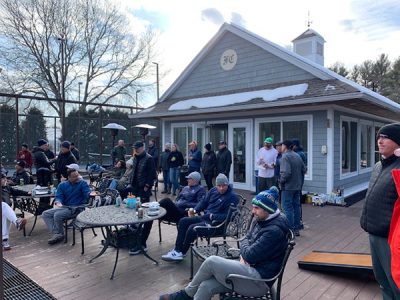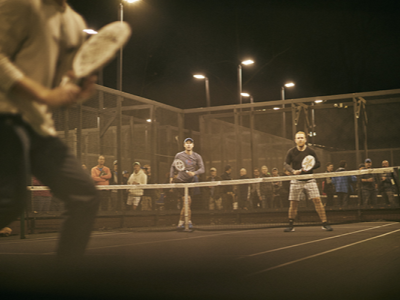NEWS
League Lines -APTA Leagues Are All Shapes and Sizes

February 16, 2023
Paddle Leagues are the APTA. Of our roughly 32,000 members, 29,000 of them join the APTA through their local league. The APTA works closely with league heads around the country to continually improve the experience for league members and the volunteers who run those leagues.
In the new League Lines series, we feature leagues from around the country. So far, two new leagues in the Midwest—Twin Cities Paddle, a small interclub league in Minnesota, and Grosse Pointe League, a partner league in Michigan—have been showcased. Over the coming seasons, we will highlight long-established and newer leagues, the leadership behind the leagues, and insights into what makes each league unique.
As a table setter for future League Lines, we wanted to give the platform tennis world a sense of the many different types of leagues out there.

LEAGUE TYPES
INTERCLUB LEAGUE Teams from one club play teams from other clubs; this type of league works well in areas with lots of clubs and courts…and accounts for the vast majority of APTA league players. Depending on numbers, leagues will typically have multiple divisions (or series or flights), and for each league match, teams will field a set number of “lines” or “courts.”
- Size: CPTC (Chicago Men) is the largest interclub league in the country with over 5,000 players. Hartford (new interclub league this season) is among the smallest Interclub league with an impressive 170 players across 5 clubs and 3 divisions in year one.
- Lines/Courts: Most interclub leagues play 4 lines/courts per match…but there are a few that are different (Cincinnati plays 3 lines, Long Island men play 6, and Boston Men play 8).
- Relegation/Promotion: Most interclub leagues use some form of relegation/promotion to move teams up and down divisions based on performance to try and establish as much parity as possible between teams within divisions. Some leagues have strict rules about who gets relegated and promoted. Others rely on league boards to use their best judgment on how divisions should be realigned between seasons.
- Leadership: Almost all interclub leagues are managed by a league board; those boards vary in size; for smaller leagues, boards often have reps from each club. As a league grows in size, the board tend to shrink to a smaller number of active/uber volunteers.

PARTNER LEAGUE Teams are made up of just two players and slotted into flights or divisions where each team plays every other team in their flight. This league structure is probably the most flexible and easiest to implement because it can handle any size, number of clubs, number of courts, etc.
- Size: Rochester has close to 1,000 players participating in several different partner leagues; some partner leagues have fewer than 100 players. Many areas with vibrant/large interclub leagues also have Partner leagues (NJ, CT, Boston). A couple of the Partner leagues field men’s, women’s, and mixed teams all in the same league/flights.
- Lines/Courts: 1 line (since it’s only two people per team). Most leagues allow teams to use subs in order to insure all matches get played.
- Relegation/Promotion: Some leagues use performance in prior seasons to realign flights; others use PTI to make up flights. The goal for all is the same—create flights of evenly-matched teams.
- Leadership: Partner leagues are typically run by one person or a very small group of people.

DRAFT LEAGUE Teams are made by captains drafting their teams from a pool of available players. This type of league works well when there’s a limited number of clubs or courts because it guarantees balance between teams (where some clubs might be much stronger/deeper than others).
- Size: Cleveland, Washington D.C., Richmond, Louisville, Charlotte, and Kansas City all have Draft Leagues ranging from 50 to 250 players.
- Lines/Courts: Typically between 3-6 lines
- Relegation/Promotion: No relegation/promotion as teams are drafted every season (usually using PTI to help guide the captains who are drafting).
- Leadership: Usually run by a small group of 1-3 people.
BOX/KING-OF-THE-HILL/LADDER LEAGUE No set teams. Each week players are assigned to a court and play one set with each of the other three players on the court. This structure works well in areas with fewer clubs or courts.
- Size: Atlanta, St Louis, and Kansas City all use this format with sizes ranging from 50 to 200 players.
- Lines/Courts: 4 players to a “Box”/Court.
- Relegation/Promotion: Each week the player with the most games won moves up a court and the player with the least games won moves down a court.
- Leadership: Usually run by one person.

INTRA-CLUB LEAGUE Many clubs form their own internal leagues using the Draft, Partner, or Box league formats. This works well both for clubs in areas with vibrant interclub leagues (where Intraclub acts as a supplement to Interclub play) and also for areas where there aren’t enough clubs for Interclub play.
- Size: Columbia Country Club has over 350 players playing in Intraclub league matches (particularly impressive given they have 4 courts).
- Lines/Courts: Varies
- Relegation/Promotion: Varies
- Leadership: Usually run by the club pro or a member volunteer.
START A LEAGUE/ BRING A LEAGUE INTO THE APTA NETWORK
The APTA is always excited to help new leagues of any size and structure get started. We’ve been very fortunate to partner with Paddlescores (league management software) to help make setting up and running a new league as easy as possible.
Please reach out to APTA CEO Amin Khadduri at amin@platformtennis.org with any questions.
